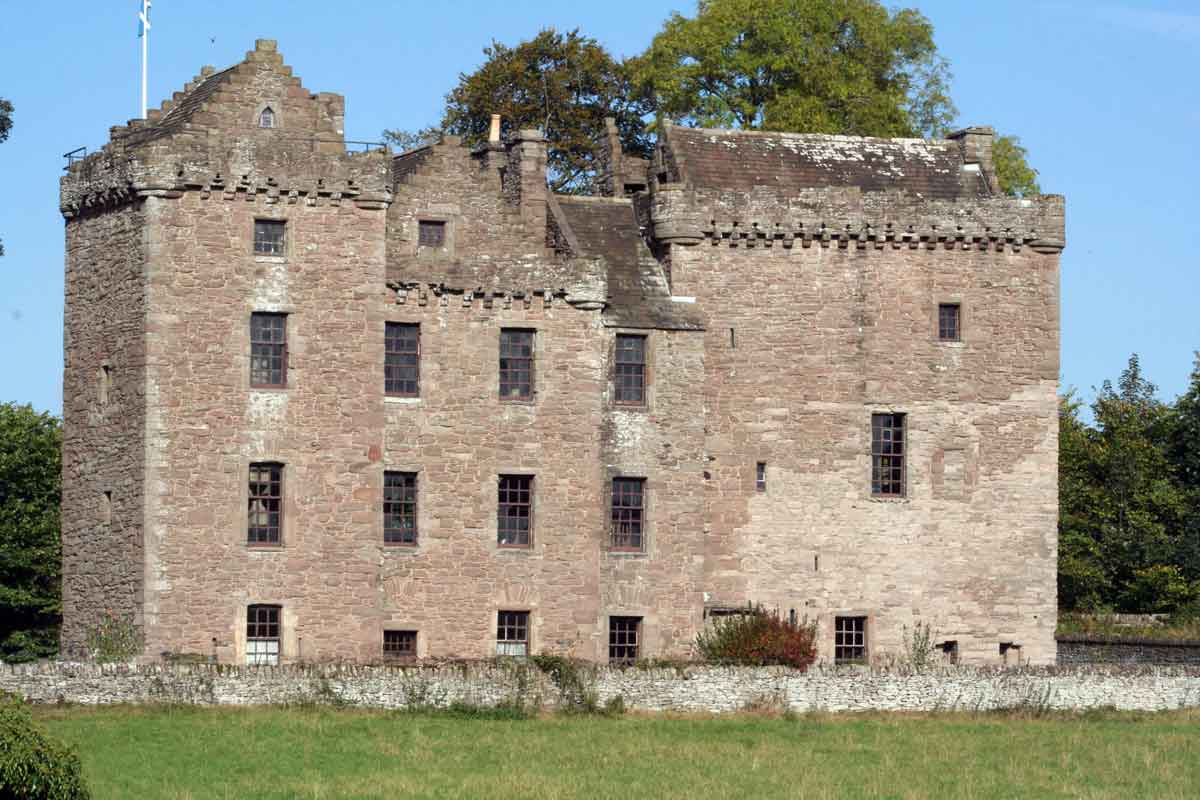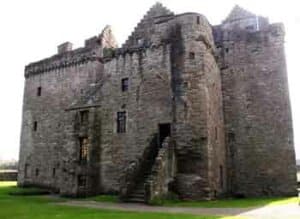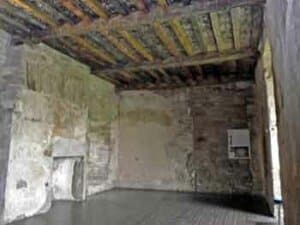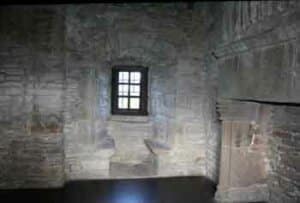
The history of Huntingtower Castle
Huntingtower Castle, known as the House of Ruthven or Place of Ruthven until 1600, sits on the outskirts of Perth on land that was once part of the Roman Empire’s northern frontier.
Although now under pressure from an ever-expanding modern environment, it was for over three hundred years, between the 15th and the 18th century, the family home of two of Scotland’s noble families: the Ruthvens, later the earls of Gowrie and after their fall from grace in 1600, the Murrays, earls of Tullibardine, later the dukes of Atholl.
The building, not a castle in the traditional sense, consisted until the 17th century of two separate tower houses built less than 10 feet apart. Although there are other examples in Scotland of similar designs, Huntingtower is unique in that the towers are so close.
Sadly, the great hall which stood to the north of the west tower has now disappeared as have other buildings that once formed part of the castle complex.
Dating Huntingtower Castle
Dating Huntingtower castle precisely is problematic but Historic Environment Scotland which now manages the site makes a judgment on stylistic grounds.
For example, the fireplace on the second floor of the east tower is dated to 1500, in comparison, the coat-of-arms on the wall of the west tower is dated to before 1513. The gun holes, common in both towers, are dated to between 1480 and 1530.
The building is unemotionally described by the Royal Commission on the Ancient and Historical Monuments of Scotland (RCAHMS) as two tower houses linked by a one-bay addition in the 17th century.
Maiden’s Leap
The gap between the towers is known as the ‘Maiden’s Leap’. In a story told by Thomas Pennant, an 18th century Welsh writer and naturalist, he tells us that one night the daughter of the 1st Earl of Gowrie leapt from one tower to the other to ensure her mother did not find out she had spent the night with her lover.
Although her mother was persuaded that nothing untoward had happened that night it seemed the couple eloped the next day and were married.
The buildings present an interesting configuration which raises the question, why was it designed this way? Historic Scotland suggests the answer might lie in the arrangement made by Sir William Ruthven, the first Lord Ruthven, to divide the land between his sons William and John, a scenario which required the building of two homes.

The medieval towers with their evocative nooks and crannies, one of the oldest painted ceilings in Scotland and a few exquisite fragments of painted wall plaster offer those with a perceptive eye a chance to imagine how life once was.
Nonetheless, despite its obvious artistic charm, it’s the intriguing story of its occupants, particularly the Ruthvens and their many notable visitors which demands our attention.
While life at the House of Ruthven was often swept along in the ebb and flow of wider Scottish affairs there are a number of events involving the family that will forever remain part of Scotland’s historical legacy.
In 1553, Patrick, third Lord Ruthven, part of a family with links to Perthshire since the late 12th century, was again Provost of Perth a position he held until his death.
Mary of Guise and the Protestant Lords
In a country deeply divided by religion, Ruthven was a man with Protestant sympathies, a mediator between the Catholic regent Mary of Guise and the Protestant Lords of the Congregation and who subsequently attended the Reformation Parliament of August 1560.
Following the death of Mary of Guise, her daughter Mary Queen of Scots returned to Scotland from France in August 1561, a Catholic queen in a Protestant country.
The debate over possible suitors for Mary was a contentious one but she eventually married Henry Stewart, Lord Darnley, an unpopular choice for many in Scotland.
As both were potential successors to the English throne the news was also treated with hostility at the court of Elizabeth I. There were few who liked Darnley a drunkard with a less than glorious reputation, a man with an “insolent, imperious temper.”
Following their marriage, there were immediate divisions, with Darnley growing resentful of the close relationship between the queen and her closest companions which included David Riccio (Rizzio) her Italian court musician and private secretary.
Ruthven, an adherent of Darnley had declared his support for the marriage and was their host when in March 1565 the royal couple stayed at his castle during their honeymoon.
However, Mary didn’t hide her dislike of Ruthven. She said in a conversation with John Knox: “I cannot love Lord Ruthven, for I know him to use enchantment; and yet he is made one of my Privy Council.”
C.J. Guthrie who edited (for popular use) John Knox’s weighty The Reformation in Scotland noted that in communication between Thomas Randolph, described by Knox as an agent for the Queen of England, and William Cecil, Lord Burleigh “that the queen cannot abide Lord Ruthven; and all men hate him.”
Mary Queen of Scots
Antonia Fraser, Mary Queen of Scots wrote: “The character of Darnley was like a tinderbox on which it was all too easy for the disaffected nobles to strike a flame, using Riccio as a flint.”
On 9 March 1566 Mary, pregnant and in poor health, was holding a supper party with a small group of friends, including David Riccio, in her apartments in the Palace of Holyroodhouse in Edinburgh. The atmosphere was “innocuous and domestic rather than exciting.”
Antonia Fraser described the unexpected entrance of Patrick Ruthven into the Queen’s apartments. She wrote: “Patrick Lord Ruthven, with a steel cap on and with his armour showing through his gown, burning-eyed and pale from illness…”
Ruthven and his co-conspirators entered from the staircase which connected Darnley’s apartment to Mary’s. With Ruthven berating the queen over recent policies while also declaring that Riccio had offended her honour, the Italian was dragged out and brutally stabbed to death.

In the end however, the murder of the unfortunate Riccio was seen as merely a symbolic gesture, part of a wider plot, an attempt to seize political power, to control Mary’s council.
Patrick Ruthven died in Newcastle within months of Riccio’s murder. His son William closely involved in the incident also fled to England.
With the death of his father, William, 1st Earl of Gowrie, became master at the House of Ruthven. Although denounced as a rebel he was subsequently pardoned and allowed to return to Scotland before the end of the year.
In February 1567 Darnley too was murdered and although never proved suspicion fell on James Hepburn, 4th Earl of Bothwell, who became Mary’s third husband. Mary too was implicated but the truth still remains a matter of speculation.
Battle of Carberry Hill
In June, following the ‘stand-off’ between Mary’s forces and the Lords of the Congregation at Carberry Hill near Edinburgh the queen was led away and committed to imprisonment on a small island in Loch Leven. It was William Ruthven who signed the order and became one of her custodians during her time on the island.
However, at some point, in a strange twist, it was said “Ruthven is employed in another commission, as he began to show great favour to her [Mary] and give her intelligence.”
The Calendar of State Papers (CSP) relating to Scotland and Mary Queen of Scots notes that she claimed that Ruthven had made protestations of love to her. Despite this, it was the Earl of Gowrie accompanied by Lord Lindsey who forced her to sign a Deed of Abdication.
Although in May 1568 Mary did escape from her island prison, she spent the following 19 years of her life in England as a ‘guest’ of her cousin Elizabeth. She was beheaded at Fotheringhay Castle on 8 February 1587.
In July 1567, James VI of Scotland (in 1603, James I of England), following the forced abdication of his mother, became king at the tender age of 13 months.

By the age of four, in a country where Catholic worship was outlawed, his education was heavily influenced by his principal tutor George Buchanan with “Presbyterian and Calvinist political doctrine.”
However, despite the changes forced by the Scottish Reformation Scotland was still a country divided by faith.
Over the following years, the Earl of Gowrie was politically and militarily active but it was the events of 23 August 1582 that he will be best remembered. It was a 16th century coup d’état now known as the Ruthven Raid.
During his minority a number of regents ruled on the king’s behalf, he was also surrounded by others driven by a single-minded determination to influence him.
Among them were Esmé Stewart, first Duke of Lennox, an older and charismatic cousin and James Stewart, Earl of Arran. Lennox was French and had Catholic sympathies and that worried the Earl of Gowrie.
It also worried Elizabeth I, particularly after Lennox was implicated in a Spanish plot to remove her, free Mary Queen of Scots and place her on the throne of England. Although Lennox denied he was a “deviser of the erecting of papistrie” the die was cast.
House of Ruthven
With the support of the earls of Angus, Glencairn and the Scottish Kirk which labelled the event “the late action of the reformation,” Ruthven seized the opportunity by luring the 16-year-old James to the House of Ruthven where he was held against his will. For ten months the king remained a captive and power in Scotland lay with the conspirators.
Despite the affirmation that Scotland would continue along the Protestant path, there was little support forthcoming from England.
While the Earl of Gowrie had obvious concerns about Catholic influence in Scotland, he also had personal financial concerns over large sums of money that the crown owed him.
By June 1583 the earls of Huntly, Crawford, Argyll and Rothes, all supporters of Arran and Lennox, had freed the king. James was taken to St Andrews for safety.
Gowrie arrested and executed
Although James was initially magnanimous and pardoned the group, a further coup was attempted at Stirling in April 1584. Its failure forced some of the group into exile in England but Gowrie was arrested and executed for his involvement. His estate including the castle was forfeited to the crown.
In 1586, James VI restored the 1st earl’s estate and titles to his son James Ruthven who died only two years later at the age of only 14. His younger brother John succeeded as the 3rd Earl of Gowrie.
John Ruthven was by all accounts a distinguished scholar of the ‘natural sciences’ with time spent at the universities of Edinburgh and Padua in Italy where he is commemorated as one of the 40 ‘greats’ from Europe.
More Scottish Castles
Ruthven, in a hall where Galileo once taught, is still remembered today as part of an eclectic assembly that includes novelist and poet Oliver Goldsmith and Sir Francis Walsingham, principal secretary and ‘spymaster’ to Elizabeth I of England.
His return to Scotland in 1660 triggered one of the most bizarre and still fully unexplained incidents in Scottish history.
There are inevitably weighty and competing accounts of the event, the official (the king’s version) which is disbelieved by many scholars and the one documented in the Ruthven Family Papers, a manuscript (edited by Samuel Cowan 1912).
This not only considers the events of August 1660 it offers, for the serious student, a more detailed account of the Ruthven family history. Later studies by Arbuckle (1957) and Lee (1980) offer more contemporary opinions.
In an attempt to add some clarity, Historic Environment Scotland poses the question: “was Gowrie trying to engineer another coup d’état or was the king cunningly ridding himself of one of his enemies?” That question has never been answered.
Whatever the circumstances the king and his entourage arrived at the Gowrie’s townhouse in Perth and some kind of struggle followed. There are records that say that the king, spotted at a turret window, was heard to shout “I am murdered! Treason! My Lord Mar help…”
Edinburgh Tollbooth
It was however the earl and his brother Alexander who were killed. Their bodies were forbidden burial and taken to Edinburgh for a posthumous trial where the only evidence offered came from those loyal to the king.
In November they were both found guilty of treason and their bodies were hanged, drawn and quartered. Their heads were displayed at the Edinburgh Tollbooth, their limbs were put on show around Perth and their estates were annexed to the crown.
The name of Ruthven was abolished and their arms were removed from the Book of Arms. From that time the House of Ruthven became known as Huntingtower.
The change of name marked a change of fortunes at Huntingtower as a series of keepers took up residence in the castle. It wasn’t until 1663 that James Murray, the 4th Earl of Tullibardine was granted ownership outright. On his death, the castle passed to his cousin John, 2nd Earl (later Marquis) of Atholl.
By 1805 the castle was sold to James Buchanan the owner of a cloth printing factory, who used it for housing his workers. It was an ignominious descent into anonymity for such a fine historic building.
Huntingtower Castle was transferred to state care in 1912 and slowly restored, perhaps not to its former glory but certainly, for its many visitors, it became a window into another age.
Huntingtower Castle is the perfect day trip from Edinburgh
For information on opening hours, cost of entry and other tips to help you plan your visit, go to the official castle website.